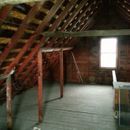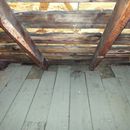Insulating walk-up attic space
I own a house in Detroit (zone 5) that I am renovating and will probably sell when ready. The house has a basement, 2 floors, and a walk-up attic. The total square footage per floor is about 550 square feet.
The house has cedar shake siding with no insulation in the walls. It has about 2 inches of vermiculite insulation below the floor boards in the attic. The attic has a peaked roof and measures about 11 feet from the floor to the ridge board. There are no soffits and no venting (other than generally being vented or leaky everywhere.) There is a window at each gable end in the attic.
I had been thinking about putting down 1/2 inch plywood over the entire attic floor, taping the seams, and blowing in cellulose. This would render the attic space unusable but would probably be the cheapest option. If I do that I am uncertain what to do around the edges. For the plywood to add any airtightness, I assume that the edges would have to be sealed down to the level below the attic floor.
Is there any need for rafter vents (baffles) if there are no soffit vents? Would it make sense instead to spray closed cell foam around the perimeter up to about 18″ to seal the edges and block the cellulose from contacting the roof sheathing?
I would like to insulate the attic although I am uncertain of the payback when selling the house. Since it is an expensive house to heat, I would think that insulation would be a good selling point. Any thoughts? Thanks.
GBA Detail Library
A collection of one thousand construction details organized by climate and house part











Replies
Gregory,
To do a careful job, there are several issues to consider.
1. Ideally, you need to air seal the ceiling before you add more insulation.
2. You need to make sure that there is an uninterrupted transition between the air barrier at your exterior walls and the air barrier at your attic floor.
The job is complicated by the fact that the existing insulation is vermiculite, which may contain asbestos. (For more information on vermiculite, see Insulating the attic of a 1850s Cape.) Because of the vermiculite, it probably makes sense to install plywood above the existing boards, as you propose. But there are health concerns; it may be wise to stay out of the attic until an asbestos abatement contractor has removed the asbestos.
Because there are health consequences to a mistake, I would be conservative and call an asbestos abatement contractor for advice.
I've done some more reading on the vermiculite issue and it sure does complicate things. I have found commenters at the finehomebuiding forum and elsewhere who claim the risk is overblown. Apparently the tests are so unreliable that the EPA says to just assume that any vermiculite from before 1990 contains asbestos. The problem may be that even the vermiculite from the Libby mine did not all contain asbestos, so samples from various spots in the same attic may show some asbestos or none.
In the process of patching plaster damage in the second floor ceiling, I had a helper who decided that the crumbly stuff above the wood lath was best pulled through into a pile on the floor prior to starting to patch. So the vermiculite has been disturbed. We vacuumed it up with a HEPA filter in the shop vac.
Unfortunately, if the prices for asbestos abatement are as high as I've seen mentioned, ($4 to $8 per square foot) then I may just sell the house as is. I had hoped to upgrade the insulation as part of the renovation, but the payback for added insulation at resale is probably questionable at best, and with the added cost of Hazmat style removal of the vermiculite, unaffordable. Spending a few hundred on cellulose and blower rental seemed to make sense. Spending a few thousand, not so much.
This same house has what I assume to be asbestos wrapped insulation ducts in the basement. It has a large natural gas gravity furnace. A water leak left some of the duct wrap hanging in shreds. I was thinking about just wrapping it with a good metal tape to encapsulate any asbestos.
Would it be crazy to don a good respirator, wet down the exposed vermiculite in the attic, then vacuum it up with my hepa equipped shop vac?
Gregory,
There are good reasons why asbestos abatement is expensive. Asbestos is a health hazard. If you try to engage in do-it-yourself abatement, you are not just putting your own health at risk; you are potentially putting the health of the future owners at risk. Don't do it.